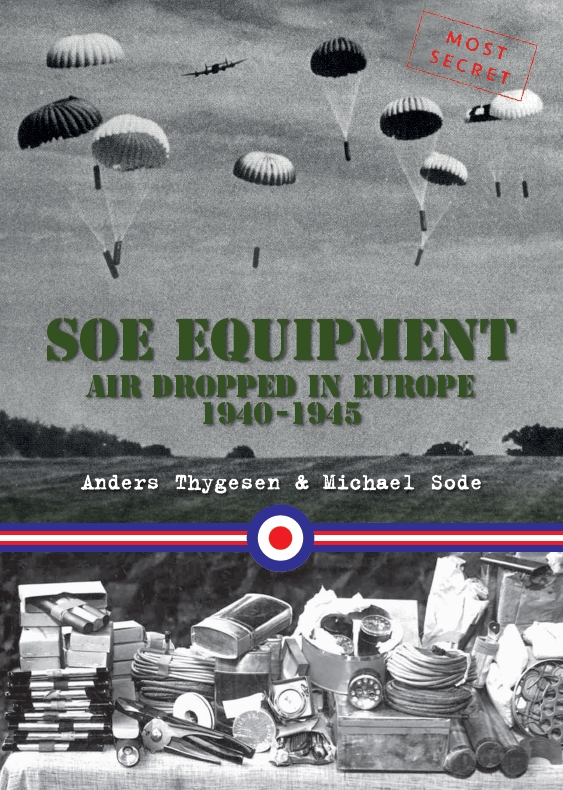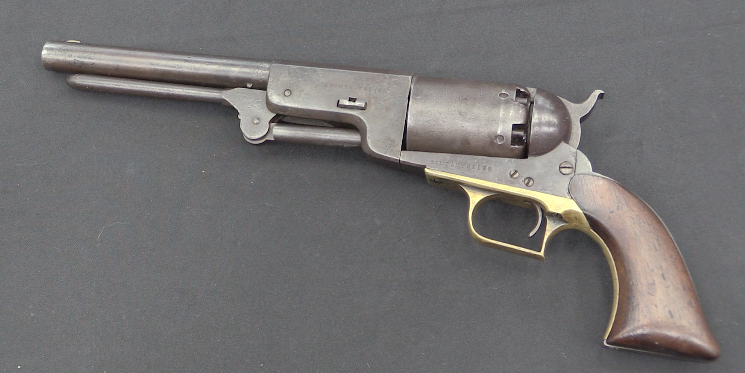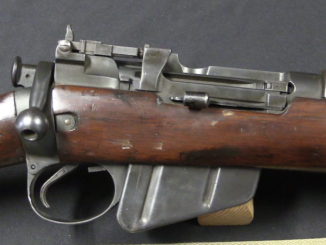Today we are taking the ZX-7 (essentially a Sterling SMG in .45 ACP) out to the range. It runs rather faster than I initially expected, but isn’t too hard to handle…
Related Articles

Accessories
Book Review: SOE Equipment Air Dropped in Europe 1940-1945
A while back I posted a review of a great little paperback account of Winston Churchill’s Toyshop – the development of clandestine warfare gear for use by saboteurs and resistance movements in occupied Europe during […]

Percussion
1847 Walker Revolver at RIA
The Colt 1847 Walker revolver was a massive 4 1/2 pound handgun made for Samuel Walker of the US Mounted Rifles (he also served with the Texas Rangers) as a way to equip mounted troops […]

Bolt Action Rifles
A New Enfield for a New War: The No4 MkI
The stalwart No1 MkIII “Smelly” served the United Kingdom well during the First World War, but by the 1920s it was growing obsolescent. The war had revealed a number of shortcomings of the design, and […]

I’ve said it before, but, You are HAVING TOO MUCH FUN, doing these videos!! I wish I could have found such a job back when I was younger!! Good video, Great video site, Thank you!!!
The thing is he didn’t find that job he created it for himself. But I agree wholeheartedly that he does look like he is having too much fun. At least we can live vicariously through Ian’s obvious passion.
sounds like fun to me. though I’d like more like a nice slow 450-500rd/min. if you ever come across a 45 funswitch uzi… always wondered about those. never saw (hmm.. never searched for vids exactly neither) any footage about a 45 uzi.
Dude! You went muzzle down on the empty mag trigger pull!
Anticipating recoil.
Interesting comment about having a loose grip on the forebarrel. I used to ride track bikes some, the oval banked velodrome — no brakes, no gears,no freewheel, don’t try to coast, just go hard and turn left. One of the things I was told about, but didn’t believe, was that trackies have a very light touch on the handlebars. You could ride up next to a trackie and *blip* easily knock their hands off. Turned out to be mostly true, and made me a better bike rider off the track too. Even sort of applies to life itself, but I wouldn’t get carried away saying the track taught me how to live better.
“Very simple SMG” (C)
Too simple.
At the same time, there is a “bunch of unnecessary parts” in the bolt, but not what is needed.
Namely, forward ignition and correct return and buffer mechanisms.
We are also waiting the .32 ACP at the range 😀
Every time I see his ‘show of force’ I think for myself: could this ammo be used more productively, out of pistol?
I know the answer already… NO, it cannot. The passion must get thru 🙂
“(…)could this ammo be used more productively, out of pistol?(…)”
This immediately reminded me bit from League of Extraordinary Gentlemen movie
Allan Quatermain Now, would you like to learn to shoot?
Tom Sawyer I can already.
Allan Quatermain Oh, I saw. Very American. Fire enough bullets and hope to hit the target.
This is so much ingrained in American psyche, nothing can be done about it. It is apparently part of “abundance of everything” mentality they grew used to and will have difficulty to part with.
But, but, but… when it comes to military field applications they are running into a snag – need for steady ammo supply.
There is that so much emphasized term “firepower”. For some it may be the number of bullet which left muzzle. For me it is a number of bullets which HIT target. But, let everyone to decide on their own 🙂
Firepower as in bullets in the air is there to compensate for the shortcomings of the average soldier as a marksman. We can’t make armies all dedicated marksmen and special forces, therefore firepower is needed to suppress the enemy and also cause casualties. Your definition of firepower would be fine if we could make armies exclusively from “super-soldiers”, but as long as humans are humans, it is simply not possible beyond small scale operations suitable for special forces. Mind you that I am of course talking about crew served machine guns, not so much about individual weapons, which do not benefit so much from the firepower advantage of full auto fire.
Denny, I’m not sure what you’re basing your opinion on, because it’s false.
If anything, the American vice when it comes to small arms and small arms doctrine is the cult of the individual rifleman uber alles. You go looking back along the history, and that’s been the driving force behind the M1 Garand, the M14, and most of the other stupidities we got up to. Even before that, you have to look at the Civil War era, when they didn’t want repeaters, ‘cos “ammo waste”.
Yeah, there are a lot of civilian shooters who love expending ammo, but the military and the doctrine people in that military? They have the diametric opposite problem–They think that there’s no real place for firepower in the equation. Look at the M16A2 and the three-round burst selector, for another example.
The reality is, if they thought they could get away with it, we’d be running around with semi-auto only weapons, if not some kind of single shot travesty that would “force the soldier to consider each shot”. Look at NGSW, which is approaching the outer limits of controllability on fully automatic, for yet more proof of that.
No, you want to discuss people with a fixation on firepower, you need to look at the Germans and the Russians. The Germans built everything around the LMG; the Russians built everything around what amounts to an intermediate-caliber SMG. They’re the ones you ought to be mocking for being firepower-obsessed. The US isn’t firepower-obsessed; we’re firepower-oblivious. I think that out of a 25-year career in the combat arms, I had one, count it, ONE dedicated range where we did full-auto on our M16 rifles. That was in Basic Training, and was meant to familiarize us with what it would be like to fill the Automatic Rifle role with the M16–And, that range block was later replaced with familiarization fire with the SAW M249.
So… Yeah. Your thesis is flawed. Don’t take the civilian enthusiasm for more bangs as anything other than that of a community that has the capability and a fascination with it all, rather than a “cultural feature”.
I would have rather seen this done as an Owen in .45 Auto. Top feed, so no offset weight and a heavier overall weapon.
As always, thank you for sharing your experience!
Looking at the Patchett/Sterling, one wonders: Is there anything there, that couldn’t have been implemented and produced during the 1930s, before WWII?
Heck, for that matter… Is there anything there that couldn’t have been churned out in mass numbers for the Great War?
You have to wonder… What would WWI have looked like, fought with mid-century weapons like the Sterling? Add in things like the Claymore mine, the mortar, the 40mm grenade launcher… All of that was technically feasible, yet not implemented. The sole thing preventing it was the absence of the necessary conceptual framework that would have led to their development and deployment.
What would WWI have looked like, fought with those weapons? Less of a charnel house? More of one…? One does wonder.
I’ve forgotten which of the German guns got cloned as the Lanchester, and Patchett developed and refined from that
The MP28?
Churchill in his “early years” autobiography, said that during his training as an orificer in the hussars, grenades were museum pieces, with no place in modern warfare.
IMO the great missed opportunity of the trenches was the 1918 Christmas truce, that went on for weeks and proved very difficult for the hierarchy to break.
Just imagine the worst fears of that hierarchy coming true, front line troops turning around and coming home to sort out the people who’d sent them there
equipped with SMGs, 2″ mortars, 40mm grenade launchers and the actually existing at that time, French 38mm cannon.
The actual uprisings and revolutions which did take place in 1916 (Easter uprising in Dublin), 1917 and 1918, were (arguably) much more bitter and bloody affairs for the delay and the additional grievances.
Hi Keith,
assuming you meant 1914 Christmas truce, it was an extraordinary case of troops disobedience which, without doubt, shook up confidence of establishment supporting officer corps. It may sound inspiring, BUT for soldiers to achieve any meaningful objective (such as end of the war), they could not do it on their own – they needed a command structure.
In most armies, to open fire you need a command “On my order FIRE”. Without it you are renegade/ rebel and will be dealt with accordingly; samples thru history abound beginning with Spartacus. For this reason the oligarchy had NOT MUCH to worry about during troops return home. To make sure to derail any antisystem thought they celebrated them as “war heroes”. Marching bands, medals, speeches etc., as usual.
What Irish republicans achieved was extraordinary; they used the high of war as unique opportunity to liberate themselves – perfect timing. However, they too DID have a command structure of their own. Much like the underground Polish army during WW2. Without it they could NOT make it as they did.
“(…)things like(…)mortar(…)was technically feasible, yet not implemented(…)”
Now I am extremely confused, as mortars were used during Great War so far I know.
Few examples:
9.15cm Leichter Minenwerfer System Lanz (Austria-Hungary)
142mm Delattre Mortar (Belgium)
Mortier de 58 mm T N°2 (France)
91mm m/16 Type GR Mortar (Russian Empire)
During WW2 proximity fuzes become produced in serious numbers
https://nistdigitalarchives.contentdm.oclc.org/digital/collection/p15421coll3/id/1079/
The T-171 was a generator-powered ground-approach fuse for use on the 81-mm trench mortar shell. Mortar fuses were designed for ruggedness. While the early rocket fuses were designed to withstand a firing shock 1,000 times the force of gravity, a mortar fuse needed to withstand a shock 10,000 times the force of gravity. The mortar fuse used the body of its shell as an antenna and employed standard circuit assembly techniques, unlike the similar T-132 fuse, which incorporated printed or stenciled electric circuits. The T-171 had reached a production rate of 125,000 per month when World War II ended.
Mortars were used, but most of them were relatively heavy and complex breech loading mortars with rifled barrels, which almost disappeared after WW1 (although the Germans just renamed theirs as infantry guns; the German WW2 75mm and 150mm infantry guns were direct successors of WW1 “Minenwerfer” type mortars). Their relative complexity meant that they could not be manufactured in such a huge numbers as the lightweight 81mm/82mm mortars of WW2, which all traced their lineage back to the smoothbore Stokes mortar of WW1.
Mortars of course continued their development during the interwar era. The French Brandt mortar was the most important development and sometimes modern mortars are called Stokes-Brandt type mortars. Also an important improvement was the development of fin stabilized shells which increased accuracy. The original Stokes mortar’s shells were not stabilized.
With its multi piece bolt, there’s the option to machine a replacement internal weight out of one of the machineable tungsten alloys
With a density of about 18 grams/cc compared to about 8 for steel
You should get a useful reduction in cyclic rate without any permanent changes to the gun.
With the AFI, you don’t need any Iridium shipments.
Throw away that idiotic smaller spring.
And add fiber buffer.
The rate of fire will drop to about 500-600 instead of 900-1000.
Who mentioned iridium?
Machinable tungsten alloys are readily available and until the latest craze over the last few months for tungsten desk ornaments, they were affordable and used for bolts in blowback rifles
For example Ruger 10-22 clones in .22wmr, where the greater density allows the same sized bolt to be used with the higher pressure loading
In the original Sterling, the intermediate weight and second spring, is a buffer system
It takes no part in controlling the initial opening of the bolt (unlike the weight inside the bolt)
The intermediate weight gets struck by the bolt then it ocilates too and fro, impacting on the bolt each time.
The rear spring is much stiffer and prevents an impact on the rear cap.
It’s a neat system that doesn’t degrade with use.
I Don’t know how much engineering went into transferring that system to the .45,
possibly somewhere between not much and none at all?
In Sterling, yes, it’s a buffer.
But in this case, it’s not Sterling.
And regarding “somewhere between not much and none at all”, I would say “one, but for that, illiterate.” 😉
Even if you find a router who can cut out the tungsten bolt handle stopper, it will break quickly.
Not to mention, adding 6 ounces (or so) of weight to bring the rate of fire down to 700 RPM is unlikely to work with this detail alone.
Unless you use iridium. 😉
Not to mention that with such a design of the return mechanism, it will not be able to work normally and the main spring will deteriorate relatively quickly.
Because it will compress faster than the “buffer spring” and hit the coils with every cycle.
Yes, now it works somehow.
But I think that this is unlikely to continue until at least half of the minimum period of service life.
Let’s say 3000 shots.
Or, I have a good chance to learn something really new in mechanical design. 😉
you can see why it wasn’t popular; too hard to control in full auto.
it seems to climb really bad.
Felix, off topic. but in my younger days I used to be an ice climbing fanatic. I had to incessantly remind myself that squeezing the crap out of my tool handles would not help the pick stick in the ice any better at all, just tire me out a whole lot sooner! I obviously knew it to be true but had to constantly fight the normal human stress reaction.
Now that would have been really nice in the L34 version